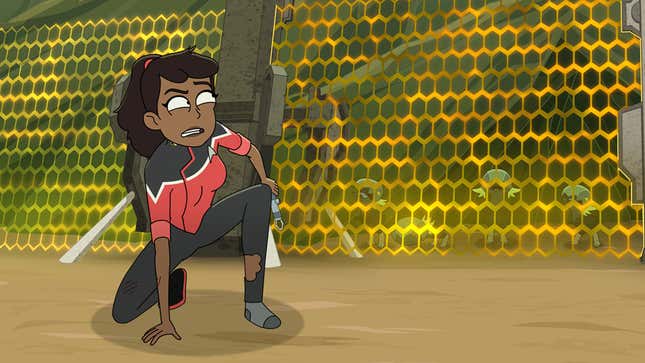Back in Star Trek: Lower Decks’ first season three years ago, it took a few episodes in before the show began to explore what it really meant to borrow its entire name and premise from the iconic TNG episode. In the years since, it’s gone on to explore that idea more holistically, but now it’s back to really dig into that namesake in a way that really works.
At first, “The Inner Fight” feels like it might be an episode setting up the same kind of frustrations that went into the finale of season three’s similarly frustrating arc for its heroes—especially for Beckett Mariner, who has struggled to really find a story path forward ever since season one explored the reasons behind her rebellious person. After not just her friends but her mother and captain realize that Mariner is on a destructive spiral of accepting more and more dangerous away missions, “The Inner Fight” splits off into two important forks as Lower Decks sets the stage for its latest finale.

Aboard the Cerritos, Captain Freeman begins an investigation into a series of former Starfleet officers, after learning that the mysterious ship hunting down vessels all season—capturing their crews rather than destroying them as previously thought—is now targeting ex-Starfleet personnel, including the likes of big hitters like Beverly Crusher and Seven of Nine (in a nice tie-into their eventual arcs on Star Trek: Picard). But in true Lower Decks style, the Cerritos’ assigned investigation is to follow on the heels of Nick Locarno, Robert Duncan McNeill’s pre-Tom Paris Trek role as a student booted out of Starfleet Academy for trying to cover up a fatal shuttle accident. Basically a nobody, just enough of a somebody, and a nerdy Trek nod the show can use to hold up a mirror to its own characters? That’s perfect Lower Decks territory.
All that’s well and good, and comes together in the climax of the episode, but the real meat of “The Inner Fight” is Freeman tasking Boimler, T’Lyn, and Tendi with distracting Mariner on a boring, risk-free away mission (monitoring a buoy above the storm-wracked planet Sherbal V) so she doesn’t get caught up in any more danger like she’s been gung-ho for. Naturally, an episode of Star Trek where nothing actually goes wrong would be quite underwhelming, especially as setup for a season finale, so after investigating the buoy, Mariner and her friends find themselves confronting a cloaked Klingon Bird of Prey, which scuttles their shuttle, leaving them no choice but to perform an emergency beam out to to the planet below.

What they all find there is the worst-case scenario for setting off Mariner’s recklessness all over again. Beyond being stranded, Sherbal V is seemingly where all these missing crews are being kept captive, creating a kind of Hunger Games-ian perpetual battle royale for survival: and instead of waiting for her friends’ plan to find and re-adapt a local comms station into a distress beacon, Mariner gladly races off into the night and finds herself fistfighting a Klingon during rain that literally buckets down shards of crystalline glass. It’s in this crucible, taking shelter with the Klingon she was fighting just moments ago—Ma’ah, from the excellent season two episode “wej Duj”—Mariner is forced to confront the ways she’s been feeling, and crucially so on her own (or, with Ma’ah at least) instead of to her friends so she can really open up. And in one simple soliloquy Lower Decks doesn’t just solve its most important character’s biggest internal conflict, but does so by bringing us all the way back to its TNG namesake.
Mariner reveals that at the academy she was best friends with none other than Sito Jaxa—a Bajoran Ensign who, as Mariner reminds us, was assigned to the Enterprise-D, and reminds us furthermore that she was killed in action after volunteering for an extremely dangerous mission. Compounding that heartbreak of losing her best friend, the Dominion War broke out shortly thereafter, and people like Beckett—relatively fresh graduates who joined Starfleet to explore and investigate, to experiment and communicate with the galaxy around them—were turned into front line soldiers in a conflict that nearly obliterated the galaxy as they had understood it as young people and as young Starfleet officers. And in experiencing it, Mariner’s rebellious streak was radicalized in tragedy: she hates the authority of leadership not because it restricts and controls her, but because she came of age in a time where that leadership meant sending friends to die, where success put you in the crossfire of a war unlike anything her generation had ever seen.

On screen Star Trek has had rare chances to really explore the ongoing impact of what the Dominion War did to Starfleet and its heroes, beyond the character arcs immediately impacted in Deep Space Nine. Placing Lower Decks in this crucial timeline, and cleverly weaving its arguably most important character into the legacy of that event—and really tying her even further into the episode that gave Lower Decks its entire initial being—leads to a masterstroke three years in the making for Mariner as a character, at long last a climax to her on-and-off desire for what she wants out of Starfleet. In accepting what Ma’ah tells her, that Sito, that all the victims of the Dominion War, died to preserve the ideals of Starfleet that she wants to embody, finally something is catalyzed in Beckett that we’ve only been able to see glimmers off in the past—glimmers, because she had yet to truly address the trauma behind it all. It feels earned that it has taken all this time, and that it has come in fits and starts, as frustrating as it has occasionally been for the audience, by re-contextualizing that journey through the frame of Star Trek history itself. Of course this took time, the Dominion War sucked!
If the other plot of “The Inner Fight” being a wild goose chase for Nick Locarno, of all people, is a prime example of what Lower Decks can be—a silly, obscure pull on Star Trek nostalgia that reflects the show’s own askance place from the “real” heroes of the franchise—then this is another for a far more sincere reason. This kind of smart interplay between the franchise’s history and these characters, where reference is not for reference’s sake but to truly serve the emotional arcs of a new generation of Star Trek protagonists, is a clearer display of Lower Decks love of the franchise than a million Nick Locarno namedrops could ever be. It’s been a long time coming for Lower Decks and Beckett alike, but the show almost perfectly nails it.

Which is why the climax we’re left with going into the finale is so compelling—a galvanized Mariner who effortlessly slips into the command she’s always been so capable of manages to rally not just Ma’ah, but her friends and the stranded crews on Sherbal to work together and save themselves, who finds herself beamed away by the mysterious vessel that captured them all in the first place. Which is piloted, of course, by none other than Nick Locarno himself (and yes, of course, Robert Duncan McNeill is back in action). Putting this version of Mariner that we now have, one who can hold up a mirror to Locarno’s own Starfleet history as a what-could’ve-been for her own rebellious past, sets the stage for Lower Decks to do something special. It also sets the stage even further, for even more growth and change in a season that has shone for finally embracing a need for as much.
Want more io9 news? Check out when to expect the latest Marvel, Star Wars, and Star Trek releases, what’s next for the DC Universe on film and TV, and everything you need to know about the future of Doctor Who.
Trending Products

Cooler Master MasterBox Q300L Micro-ATX Tower with Magnetic Design Dust Filter, Transparent Acrylic Side Panel, Adjustable I/O & Fully Ventilated Airflow, Black (MCB-Q300L-KANN-S00)

ASUS TUF Gaming GT301 ZAKU II Edition ATX mid-Tower Compact case with Tempered Glass Side Panel, Honeycomb Front Panel, 120mm Aura Addressable RGB Fan, Headphone Hanger,360mm Radiator, Gundam Edition

ASUS TUF Gaming GT501 Mid-Tower Computer Case for up to EATX Motherboards with USB 3.0 Front Panel Cases GT501/GRY/WITH Handle

be quiet! Pure Base 500DX ATX Mid Tower PC case | ARGB | 3 Pre-Installed Pure Wings 2 Fans | Tempered Glass Window | Black | BGW37

ASUS ROG Strix Helios GX601 White Edition RGB Mid-Tower Computer Case for ATX/EATX Motherboards with tempered glass, aluminum frame, GPU braces, 420mm radiator support and Aura Sync









